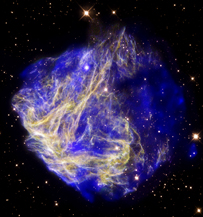 Professor Edward van den Heuvel presents "Life After Stellar Death: Supernovae, Neutron Stars, Pulsars and Black Holes"
Professor Edward van den Heuvel presents "Life After Stellar Death: Supernovae, Neutron Stars, Pulsars and Black Holes"
Neutron stars are the most compact concentrations of “normal” matter known in nature, with the strongest gravitational fields. They are the collapsed remnants of the burned-out cores of stars that started out life with masses larger than about eight times that of our sun. Everything about neutron stars is extreme: their density, gravity, magnetic field and spin. They are spheres not larger than New York City, which contain over 400,000 times the mass of Earth, so compressed that a thimblefull of their material contains as much matter as half a million Boeing 747 Jumbo jets filled with passengers and cargo. Their surface gravity attraction is a hundred billion times that on Earth, their magnetic fields are typically a trillion times stronger than that of Earth, and their spin frequencies can be higher than 700 times per second. In the past 44 years, over 1800 neutron stars have been discovered, most of them as radio pulsars, regularly pulsing sources of radio waves, but also hundreds as sources of X and γ rays. Stellar black holes are the burned-out cores of stars more massive than about twenty times the sun. They can become X-ray sources if they are in binary systems, stealing matter from a companion star.
About Home page image
 "This beautiful composite image shows N49, the aftermath of a supernova explosion in the Large Magellanic Cloud. A new long observation from NASA's Chandra X-ray Observatory, shown in blue, reveals evidence for a bullet-shaped object being blown out of a debris field left over from an exploded star.
"This beautiful composite image shows N49, the aftermath of a supernova explosion in the Large Magellanic Cloud. A new long observation from NASA's Chandra X-ray Observatory, shown in blue, reveals evidence for a bullet-shaped object being blown out of a debris field left over from an exploded star.
Credits:
X-ray: (NASA/CXC/Penn State/S.Park et al.);
Optical: NASA/STScI/UIUC/Y.H.Chu & R.Williams et al
